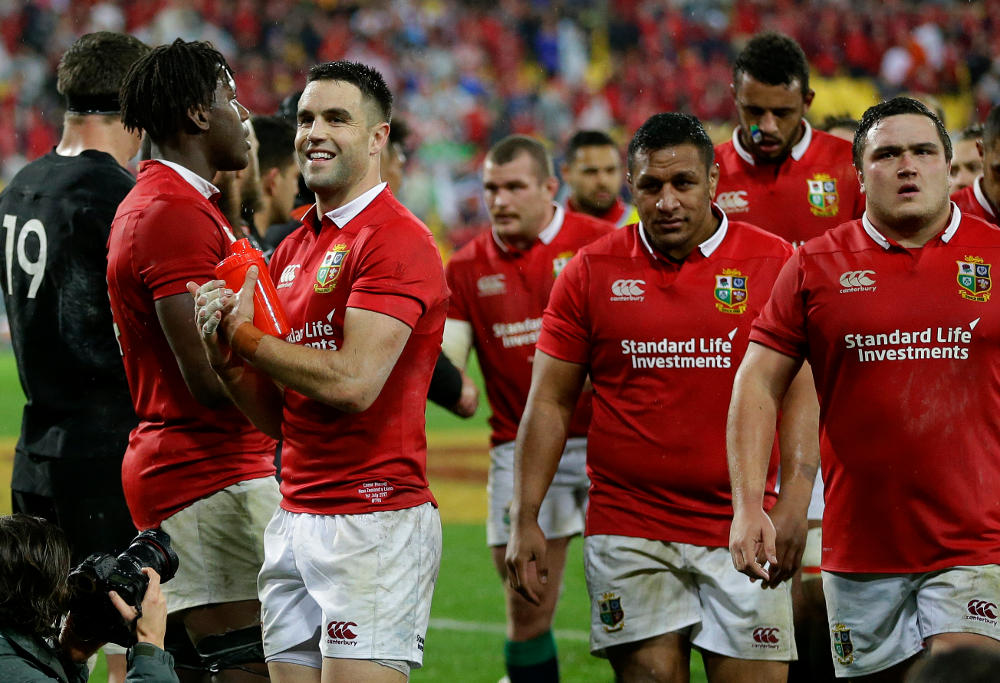Conor Murray does not look like a scrumhalf. He’s too tall. He doesn’t wriggle. He’s not a gymnast. He does not have breakaway speed. His snipes are deceptively slow – he runs upright and fends. A halfback does not usually fend.
Murray can put you in a box. You’ll know what he is going to do, but you won’t be able to stop it. He’ll box kick you into the loss column. And yet, all of Australia will be begging Will Genia not to box kick, at all.
Box kicks are seen by many as rugby heresy; a blight on the code. A cousin to the dreary mauling, the back-line equivalent of scrum resets, and the death of creativity.
Every charge down sticks in the memory forever: ‘What’s the bloody point of doing the hard work to win the ball, and then we give it away?’
A thousand ex-forwards will exclaim this simultaneously, as Genia sticks his leg out, heel embedded in the Suncorp turf, barking at his blindside chasers, dwarfed by gold-clad bodyguards.
This all the while the entire Wallaby fan-base grimacing and almost closing their eyes.
Back in Limerick, where they’ve been seeing Murray launch five-second bombs into a perfectly drawn little box since schooldays (when he had master-chaser and good mate Keith Earls to chase them), every Irish box kick will draw applause and engender confident hope.
Instrumental in Ireland’s magical rise up the world rankings, the treble of Six Nations cups, the Grand Slam, an All Black scalp, and the Lions’ renaissance, Murray’s ‘super-power’ is his box kick.

(AP Photo/Mark Baker)
There’s a Welsh halfback with a better burst from the base, a couple of Kiwis with a bit more mustard on their passes, English boys who defend better, and Genia.
Genia can do a few things Murray cannot: rescue a ball from a decimated scrum retreating at many knots, step an All Black loose forward, get into space, and outlast a wing in the race for the line.
But workmanlike Murray is at the heart of Joe Schmidt’s ‘attrition-ball’ plan.
Maybe the fact that the best skill of (in my opinion) Ireland’s best player is a ‘blue collar’ weapon – dangerous mostly because of its repetitive predictability – is the perfect summary of Ireland’s rise from ninth (2013) to second (now).
What does Murray do so well when he box kicks?
First, he understands what a box kick is: it’s a ‘box-to-box’ kick. He imagines he is trapped in a box, himself. The walls around him are thick and impervious.
The ‘box’ is small, so there’s no run-up to the boot, and he doesn’t add a shuffle back, either. He wants his chasers to know exactly what he is doing to let them be at full speed upon contact of boot-to-ball. He tries to kick the ball out of the top of the ‘box.’
The other ‘box’ Murray pictures well (and ‘paints’ like a top golfer in his prime, sticking approaches on a tricky green as if there is a magnet to a tiny area just below the pin) is the landing area. It’s uncanny.
The only other top scrumhalf I can remember with Murray’s degree of metronome accuracy on box kicks was Fourie du Preez.
One gets the feeling Murray adds a ‘box kick’ session to each week’s practice and doesn’t allow himself the fish, chips, and amber ale until he puts a set number of box kicks (20? 25?) in a row.
This, without exception, into a coned-off quadrant where he can lure opposing fullbacks, wings, number eights, and hapless flyhalves, often colliding with each other, or calling out: ‘Yours!’ at the last moment.
Second, Murray’s kicks ‘hang.’ In the last week, I have watched about 25 of Murray’s box kicks. The shortest time a box kick was in the air (not including offensive box kicks just after turnovers) was 4.3 seconds.
The longest exceeded five seconds; I swear it. Most were right at five seconds.
Out of curiosity, I took a rugby ball out on my morning run with me, and stopped at a local high school football field (I am in the steamy state of Louisiana, at the moment), and booted it as high as I could to find the apex.
It’s really hard to put a ball in the air for five seconds, even if you don’t have to care where it lands!
Giving a blindside winger and a couple of midfielders five seconds to run 30 metres, but where they have already accelerated at the time of the kick and time their contest-jump, is a recipe for success.
Third, he’s not a charge-down risk, at this point in his career. He does not even require a three or four-forward shield wall. One or two will do.
His technique is fundamentally perfect. He swivels from his plant foot and makes contact with most of his back turned to the opposing pack. The ball flight is very high.
It comes over his shoulder. His hands are soft and low; there is no elaborate ‘I am now going to kick out of the box and into the box’ windup.
Fourth, he boxes at the right time, in the right place, with the right supporting cast. A hallmark of a Murray box kick is how well he coordinates with his chasers.
In almost every box kick I viewed, Murray arranged his Shield and Chase in the phases before the kick. Not just the kick phase.
Now, Ireland’s superlative ability to retain the ball cleanly and tidily at the ruck is a contributing factor of course.
Murray is not to be pushed back at rucks. Maybe he has a loud voice? But you can see his instructions, and how well Ireland executes his shield wall and his flanking chasers.

(AP Photo/Peter Morrison)
He finds his sweet spot before he boxes. He will add a phase if he has to, in order to find the patch between 10 and 15 metres in from touch.
The scrumhalf almost never boxes too tight to touch. The ‘shape’ of play is typically tight, so that the opposing defensive line is up, aligned, and flat.
He always double-checks, or even triple-checks his target ‘box.’ I see other scrumhalves decide to box, but then not look again to see if the other team slid another player into the ‘receiving box.’ This may be where Murray’s height (6 foot 2) is a point of difference.
The other ‘reads’ Murray seems to make before boxing are:
1. He likes to have two chasers on either side, not just one. On the blindside, often it’s a wing and a fast forward, trailing, in case a counter ruck or tackle turnover is the best option.
On the open side, it’s anyone suitable, but you can see all four chasers weaving through the modern ‘blocking’ systems. Murray won’t kick until he has what he wants. But because he doesn’t require a shield on both sides of the ruck, he can usually assemble his supporting cast quickly.
2. He spies on the defensive line and sometimes aborts a box kick. Too many other scrumhalves ‘lock and load’ their box, even if the situation changes. Murray ‘audibles’ like Tom Brady.
3. Murray notices if a necessary chaser is caught up in a ruck or is limping.
4. If he sees a defender move across, robbing them of a sweeper player, he flattens his box kick and adds five to ten metres on the kick, to find grass (a ‘modified box’).
Murray is a quick box-kicker, unlike Genia. His Shield is also quick, and his chasers seem always ready to go. It’s not all about Murray. But it does seem he is the orchestra conductor from Munster.
When I hear him interviewed, Murray doesn’t strike me as too full of himself. I don’t know if that’s accurate, but he seems to diagnose the game well, even in the moment, just at halftime or after the final whistle.
So, maybe the decision on when to box kick six or seven times, and when not to box kick (two or three critical times) is just a part of his overall sense of the flow of a game.
When Ireland or Munster is going nowhere, and his internal clock says a turnover is imminent – Murray boxes. These aren’t necessarily contestable.
[latest_videos_strip category=”rugby” name=”Rugby”]
Instead, he is avoiding a worse fate, because he sees too many defenders on the blindside, or Sam Warburton is poised nicely to jackal on an angle, or Murray doesn’t have enough forwards on their feet to sustain a drive.
In a similar situation, Genia might funnel it back to Bernard Foley, fifteen to twenty metres back in the pocket, who then rushes a twenty-five-metre kick-to-touch. A five-metre ‘gain.’
Murray gets about 35 metres on his box kicks, whether hoisting them for a contest or from inside his 22 to touch. And if it’s a chase, he has chasers onside immediately at pace.
The Australian-Irish series will be a fascinating boxer versus puncher contest.
The boxer might take it – slowly and steadily.
Next, I’ll take a look at where Genia could trouble Murray and his mates.































































































